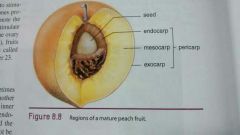![]()
![]()
![]()
Use LEFT and RIGHT arrow keys to navigate between flashcards;
Use UP and DOWN arrow keys to flip the card;
H to show hint;
A reads text to speech;
26 Cards in this Set
- Front
- Back
- 3rd side (hint)
|
fruit
|
- any ovary and its accessory parts that has developed and matured
- usually contains seeds |
|
|
|
exocarp
|
the skin of the fruit
|
|
|
|
endocarp
|
inner boundary around the seed(s)
|
|
|
|
mesocarp
|
the fleshy tissue between the other two
|
|
|
|
pericarp
|

the three regions of the fruit
|
|
|
|
simple fleshy fruits
|
- develop from a flower with a single pistil
- the ovary may be superior or inferior, simple or compound |
|
|
|
drupe
|
simple fleshy fruit with a single seed enclosed by a hard, stony endocarp, or pit
|
peaches, cherries, plumbs, olives, coconuts, almonds, walnuts, and pecans
|
|
|
berries
|
- develop from a compound ovary and commonly contain more than one seed
- three types |
|
|
|
true berry
|
thick skin and a pericarp that is relatively soft at maturity
|
- tomatoes, grapes, persimmons, peppers, and eggplants
- strawberries, raspberries, and blackberries are not berries |
|
|
pepos
|
relatively thick rinds (berry)
|
pumpkins, cucumbers, watermelons, squashes, and cantaloupes
|
|
|
hesperidium
|
leathery skin containing oils (berry)
|
citrus and kumquats
|
|
|
pomes
|
endocarp is papery or leathery (berry)
|
apples, pears, and quinces
|
|
|
dry fruits
|
fruits whose mesocarp is dry at maturity
|
|
|
|
dehiscent fruits
|
dry fruits that split at maturity
|
|
|
|
follicle
|
dry fruit that split along one side or seam
|
larkspur, columbine, milkweed, and peony
|
|
|
legume
|
dry fruit that split along two sides or seams
|
- peas, beans, garbanzo beans, lentils, carob, kudzu, and mesquite
- peanuts are atypical bc they grow underground |
|
|
siliques and silicles
|
dry fruits that split on two sides, but the seeds are on a central partition
|
broccoli, cabbage, radish, shepherd's purse, and watercress
|
|
|
capsules
|
consist of at least two carpels and split in a variety of ways
|
irises, orchids, lilies, poppies, violets, and snapdragons
|
|
|
indehiscent fruits
|
- dry fruits that do not split at maturity
- single seed united with the pericarp |
|
|
|
achene
|
base of seed attached to pericarp
|
sunflower seeds, buttercup, and buckwheat
|
|
|
nuts
|
- similar to achenes, but they are larger, and the pericarp is much harder and thicker
- develop with a cup, or cluster, of bracts at their base |
acorns, hazelnuts, and hickory nuts
|
|
|
grain (caryopsis)
|
pericarp can't be separated from the sees
|
corn, wheat, rice, oats, and barley
|
|
|
samaras
|
pericarp extends out as a wing or membrane
|
maple, ashes, and elms
|
|
|
schizocarp
|
twin fruit
|
parsley, carrots, anise, caraway, and dill
|
|
|
aggregate fruit
|
derived from a single flower with several to many pistils
|
raspberries, blackberries, and strawberries
|
|
|
multiple fruits
|
derived from several to many individual flowers in a single inflorescence
|
mulberries, Osage oranges, pineapples, and figs
|

